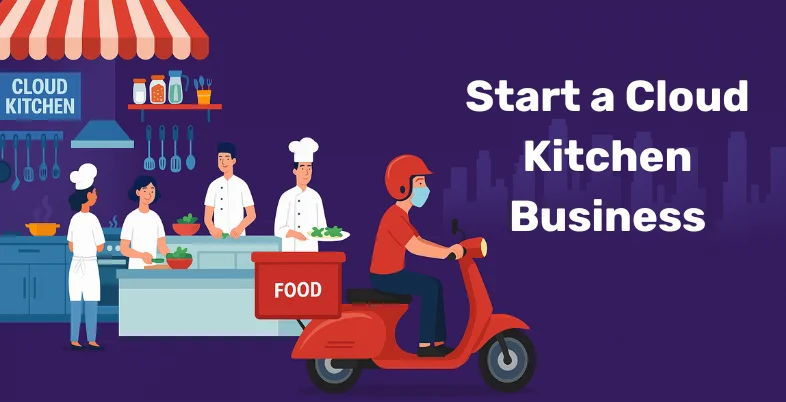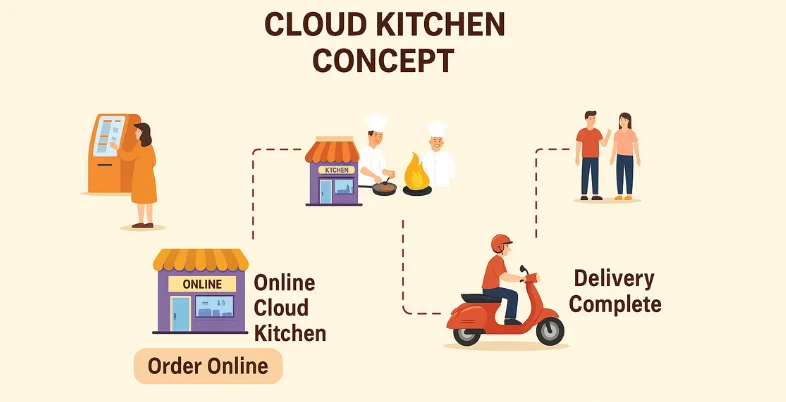
How to Start a Cloud Kitchen Business
Have you ever dreamed of launching your own food business, only to be discouraged by the soaring costs of renting a commercial space? If so, it’s time to step into the revolutionary world of the cloud kitchen business — where passion meets innovation, and culinary dreams take flight without the heavy burden of traditional restaurant setups. In this era of instant gratification and digital convenience, cloud kitchens have completely transformed the way we experience food.
But what exactly is a cloud kitchen, and how can you dive into this booming new industry? Whether you’re a seasoned chef, an aspiring entrepreneur, or simply someone with a love for great food, this journey will unlock everything you need to know — from choosing the perfect location to mastering the digital art of attracting hungry customers online. Get ready to awaken taste buds, build a powerful brand, and satisfy cravings on a massive scale — all from the comfort of your very own cloud kitchen!
What is Cloud Kitchen?
Instead of serving customers on-site, cloud kitchens focus entirely on preparing food for online orders and deliveries. Customers place their orders through food delivery apps like Swiggy, Zomato, Uber Eats, or through the kitchen’s own website or app, and the food is delivered directly to their homes.
Cloud kitchens are designed to reduce the high costs associated with running a full-scale restaurant, such as renting expensive commercial property, hiring front-of-house staff, or investing heavily in décor and furniture. By operating from a simple, efficient kitchen setup, entrepreneurs can focus more on quality food, speedy service, and customer satisfaction. Many cloud kitchens even run multiple brands from a single kitchen, offering different cuisines to appeal to a wider range of customers, all while maximizing profits from a single location.

Steps for How to Start a Cloud Kitchen
Starting a cloud kitchen might sound overwhelming, but if you break it down into clear steps, it becomes a smooth and exciting journey.
- Research the Market: Understand your target audience, study competitors, and identify the food trends in your area. This will help you decide what kind of cuisine to offer and how to position your brand.
- Complete Legal Formalities: Register your business and get all the necessary licenses like FSSAI food license, GST registration, Shop and Establishment Act license, fire safety, and health trade license.
- Design Your Menu: Create a smart menu with dishes that are easy to prepare, travel well, and stay fresh during delivery. Focus on quality, consistency, and affordability.
- Partner with Delivery Platforms: This will give you access to a larger customer base quickly.
- Analyze and Improve: Use customer feedback, sales data, and delivery times to continually optimize your operations, menu, and marketing strategies.
How to do Marketing for your Cloud Kitchen?
Since cloud kitchens depend entirely on online orders, your marketing strategy must focus heavily on digital platforms. Here’s how you can effectively promote your brand and drive orders:
1. Build a Strong Online Presence
Create a professional website that displays your menu, tells your brand story, and allows online ordering if possible. Also, set up active profiles on Instagram, Facebook, and Google My Business to make it easy for customers to find you.
2. Collaborate with Food Delivery Platforms
Participate in their promotions, sponsored listings, and loyalty programs to gain better visibility and attract more customers.
3. Invest in Social Media Marketing
Post high-quality photos and videos of your dishes, behind-the-scenes content, customer reviews, and special offers. Use targeted ads to reach local audiences who are most likely to order food online.
4. Offer Attractive Deals and Discounts
Launch introductory offers, combo deals, and festive discounts to encourage first-time customers. Make sure your offers are also listed prominently on food apps and your website.
6. Focus on Online Reviews and Ratings
Encourage happy customers to leave positive reviews on food delivery apps and Google. Good ratings greatly influence a potential customer’s decision to order.
7. Invest in SEO
Optimize your website and listings with keywords like “best food delivery near me” or “[your cuisine] delivery in [your city]” to appear higher in search results and attract organic traffic.
8. Create a Memorable Brand Identity
A catchy name, eye-catching logo, and attractive packaging can leave a lasting impression and make customers more likely to remember and reorder from your cloud kitchen.
Factors to Consider When Choosing the Right Marketing Agency for Your Cloud Kitchen
1. Look for Food Industry Experience
Choose an agency that has experience working with food businesses, especially cloud kitchens or restaurants. They’ll better understand the unique challenges like food delivery marketing, app promotions, and customer retention.
2. Check Their Portfolio and Case Studies
Review their past work. Look for successful campaigns they’ve run for similar businesses. Case studies, client testimonials, and real results (like increased orders, website traffic, or app downloads) can tell you a lot.
3. Understand Their Services
Make sure the agency offers a complete package — social media marketing, SEO, content creation, paid advertising, influencer marketing, and reputation management
4. Discuss Their Strategy
A good agency will offer customized strategies based on your brand identity, target audience, and budget — not just one-size-fits-all plans.
5. Analyze Their Communication
Good communication is crucial. Choose an agency that is responsive, transparent, and proactive about sharing ideas, progress reports, and campaign results with you.
7. Ensure They Track and Analyze Results
The right agency will not only run campaigns but also constantly monitor performance, provide regular reports, and tweak strategies based on real-time results to get you the best return on investment (ROI).
8. Look for Creativity and Innovation
In the crowded food delivery market, creativity matters. Choose an agency that brings fresh ideas, creative campaigns, and innovative marketing techniques to make your brand stand out.
Suggested read:
Challenges Faced by Cloud Kitchen Owners
Supply Chain Disruptions:
Cloud kitchens often rely on suppliers for fresh ingredients. Disruptions due to weather conditions, transportation delays, or price fluctuations can impact service. To mitigate this, maintaining strong relationships with multiple suppliers, implementing buffer stock, and planning for contingencies can help ensure uninterrupted service.
Customer Complaints:
Negative feedback about food quality, delivery times, or customer service can harm a cloud kitchen’s reputation. Addressing customer complaints promptly, offering compensation (like discounts or free delivery), and using feedback to improve are essential strategies for maintaining customer satisfaction and trust.
How to Maintain Quality Control and Consistency:
Regular training for chefs and kitchen staff, along with a well-defined recipe book, can ensure that dishes are prepared consistently. Additionally, standardizing processes, using high-quality ingredients, and maintaining cleanliness in the kitchen can prevent issues related to food quality. Regular quality checks and a robust feedback loop can also help address any inconsistencies early.
Dealing with Negative Reviews and Feedback:
Cloud kitchen owners should respond to negative reviews professionally and promptly, acknowledging the issue and offering a solution, such as a replacement or a refund. Continuous improvement based on customer feedback ensures that similar complaints don’t reoccur.
Managing Peak Demand Times (Weekends, Holidays, Promotions):
Cloud kitchens face high order volumes during weekends, public holidays, and special promotions. During these peak times, managing operational efficiency becomes crucial. To handle this, it’s essential to optimize the kitchen’s workflow, have additional staff on hand, and streamline delivery processes. Forecasting demand based on historical data can help in better preparation, ensuring orders are fulfilled without compromising quality.
Staying Ahead of Emerging Food Trends and Consumer Preferences:
To stay ahead, cloud kitchen owners should keep a close eye on market trends (like plant-based foods, health-conscious meals, or international cuisines). Engaging with customers on social media platforms, running surveys, and experimenting with new menu items can help meet evolving demands. Additionally, maintaining flexibility in your menu and service offerings allows you to quickly adapt to changes in consumer preferences and industry shifts.
Scaling and Growing Your Cloud Kitchen Business
How to Scale a Cloud Kitchen
One of the first steps is increasing the delivery area. By partnering with multiple delivery platforms and improving logistics, you can reach a wider audience. Expanding menu offerings is another key strategy. Adding new items that cater to different customer preferences or dietary needs (vegan, gluten-free, etc.) can help attract a broader customer base. Additionally, considering multiple cloud kitchen locations or dark kitchens in different neighborhoods can further increase your reach and sales volume.
Investing in Marketing and Brand Awareness
To grow your cloud kitchen, it’s essential to invest in marketing and brand awareness. Digital marketing through social media platforms like Instagram, Facebook, and Google Ads can help you reach a large audience. Consistent branding—such as distinctive packaging, a unique logo, and a strong presence on delivery platforms—can help build brand recognition. Engaging with food bloggers, influencers, and running promotions like discounts or limited-time offers also helps to generate buzz around your cloud kitchen and attract more customers.
Analyzing Performance Metrics and Optimizing Operations
As your cloud kitchen grows, tracking key performance metrics such as order volume, average delivery time, customer satisfaction, and profit margins becomes crucial.
Adapting to Market Changes and Customer Trends
The food delivery industry is constantly evolving, and customer preferences change over time. Staying informed about market trends, such as the increasing demand for sustainable packaging or plant-based foods, will help you adapt your menu and operations accordingly. Engaging with customer feedback through surveys or reviews will give you insights into their changing needs and help you adjust your offerings. Being flexible and adaptable to new trends, while maintaining your brand’s core identity, will keep your cloud kitchen competitive in a fast-paced market.
Conclusion
With the right planning, creative menu, strong marketing, and focus on customer satisfaction, you can build a thriving cloud kitchen business and food delivery brand from the comfort of a small kitchen space. The beauty of a cloud kitchen is that it allows you to experiment, innovate, and grow fast in a market that increasingly values convenience and quality. By following the right steps and staying committed to your brand vision, your cloud kitchen can serve not just meals but memorable experiences to hungry customers everywhere.
FAQs
Which food delivery apps should I partner with?
You should tie up with major platforms like Swiggy, Zomato, and Uber Eats to reach a wider audience and maximize your sales potential.
What are the most difficult aspects of managing a cloud kitchen?
High dependency on delivery platforms, maintaining food quality, and standing out in a competitive online market.
 Get 50% off on Vault theme. Limited time offer!
Get 50% off on Vault theme. Limited time offer!